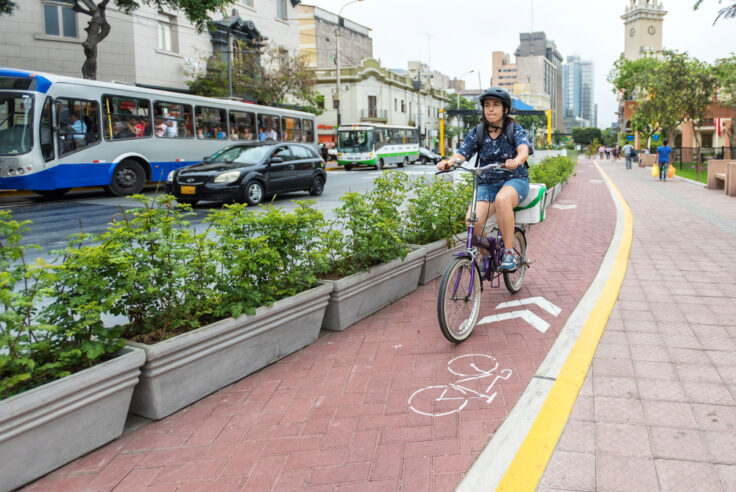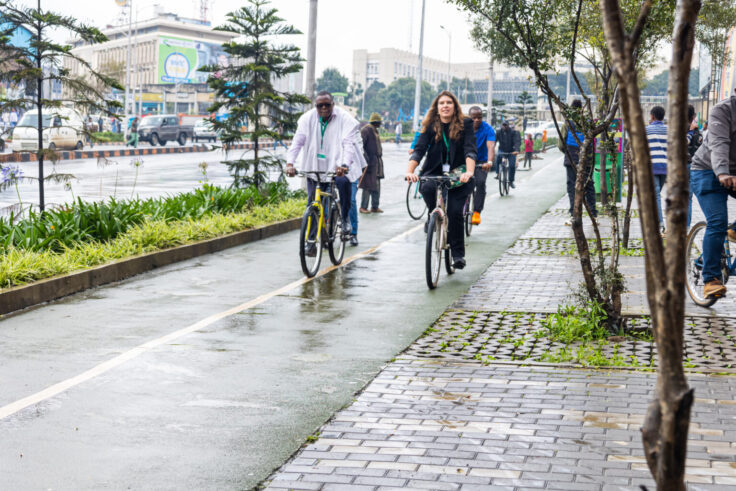January 02, 2024
Why Cities Need to Invest in Active Mobility for the Climate and Economy
In recent years, cities worldwide have faced the pressing challenge of meeting mobility needs while curbing emissions resulting from rapid urbanization and economic growth.
Investment in active mobility infrastructure supports many other urban sustainability goals.
Current urbanization trends, rising incomes, and increased vehicle ownership are steering global cities toward a future with 40% less travel done by walking, cycling, and public transport by 2050. This trend poses a significant threat, foreshadowing a substantial 33% increase in greenhouse gas (GHG) emissions from the urban transport sector. This projection underscores the urgent need and challenge for cities to decarbonize their transport systems while preserving equity and livability for all communities.
Solutions exist, however—cycle infrastructure networks, for example, are one of the most cost-effective strategies for reducing GHG emissions from urban passenger transport. By scaling up active mobility infrastructure, cities can generate climate and health benefits and strengthen investments in public transport, providing a compelling environmental and economic alternative to the current subsidies supporting motorized transport.
The Path Less Travelled: Scaling Up Active Mobility to Capture Economic and Climate Benefits is a recent report from ITDP and the World Bank that calls on urban stakeholders to acknowledge the importance of active mobility infrastructure in shaping a more sustainable future in our cities. With the right investments and a coordinated policy approach, cities can reshape their the landscapes of their transportation. The report emphasizes the need for a holistic approach to active mobility, focused on infrastructure networks that are supported by complementary elements such as bikeshare programs, bicycle parking, and capacity building. A comprehensive view of the role of this infrastructure and supportive measures can help cities better build resilience, address climate challenges, and foster economic growth for the long-term.

Nevertheless, despite the acknowledged climate and economic benefits, few cities have a complete network of protected bicycle lanes or the sustained funding needed to develop and maintain quality cycling infrastructure at scale. The report draw insights from five cities — Tianjin, China; Lima, Peru; Dar es Salaam, Tanzania; Addis Ababa, Ethiopia; and Buenos Aires, Argentina — to put a spotlight on the multifaceted benefits of scaling up active mobility, based on real-life examples. Though the city case studies are at different stages of development, they showcase the important potential for climate and economic gains from active mobility that may very well outweigh the upfront costs.
Buenos Aires and Tianjin are success stories in delivering active mobility infrastructure at scale. Buenos Aires funded its cycle lane network predominantly from the city’s budget, with additional financing from development banks, as part of a broader BRT development initiative. Tianjin’s active mobility network improvements were financed to expand access to, and encourage more usage of, the city’s metro system—a model that can be replicated in many other regions.

Download the full report here to learn key actions for cities to scale active mobility.
Lima is implementing an extensive 300 km cycle lane network with co-financing from development banks. Dar es Salaam is integrating active mobility alongside BRT implementation. Addis Ababa is laying the groundwork for a comprehensive city-wide active mobility network. These collective pushes towards high-quality cycling infrastructure have not been without their challenges, including a lack of clarity about the agency or level of government responsible for overseeing interventions, insufficient prioritization of investments, and a general uncertainty about how to fund them efficiently.
Despite such barriers, these example cities all recognize the value of promoting active mobility in order to achieve broader mobility goals, improve air quality, boost economies, and enhance public health. In this context, collaboration has been shown to be paramount. Development banks, city and national governments, philanthropy, civil society organizations, and the private sector must work together if cities are to drive smarter investments into active mobility projects. Blended financing that leverages the strengths of each type of stakeholder presents a promising and practical solution.
Perhaps most notable, the ITDP and World Bank report calls for better mechanisms for valuing the environmental and social benefits generated from active mobility infrastructure projects. Upcoming initiatives, also led by the World Bank, ITDP, and other partners, seek to standardize a methodology for conducting cost-benefit analyses for cycle infrastructure projects specifically. This work will pace the way for data-driven tools that reduce investment risks and strengthens stakeholders’ capacity to plan for and evaluate active mobility projects. Cities that enable all people to cycle safely, efficiently, and affordably are ultimately the ones that will have a healthier, greener, and more inclusive future ahead.
As we navigate the path less traveled in our cities, a sustainable and equitable world needs to be built around active mobility. Continue reading the report here.
